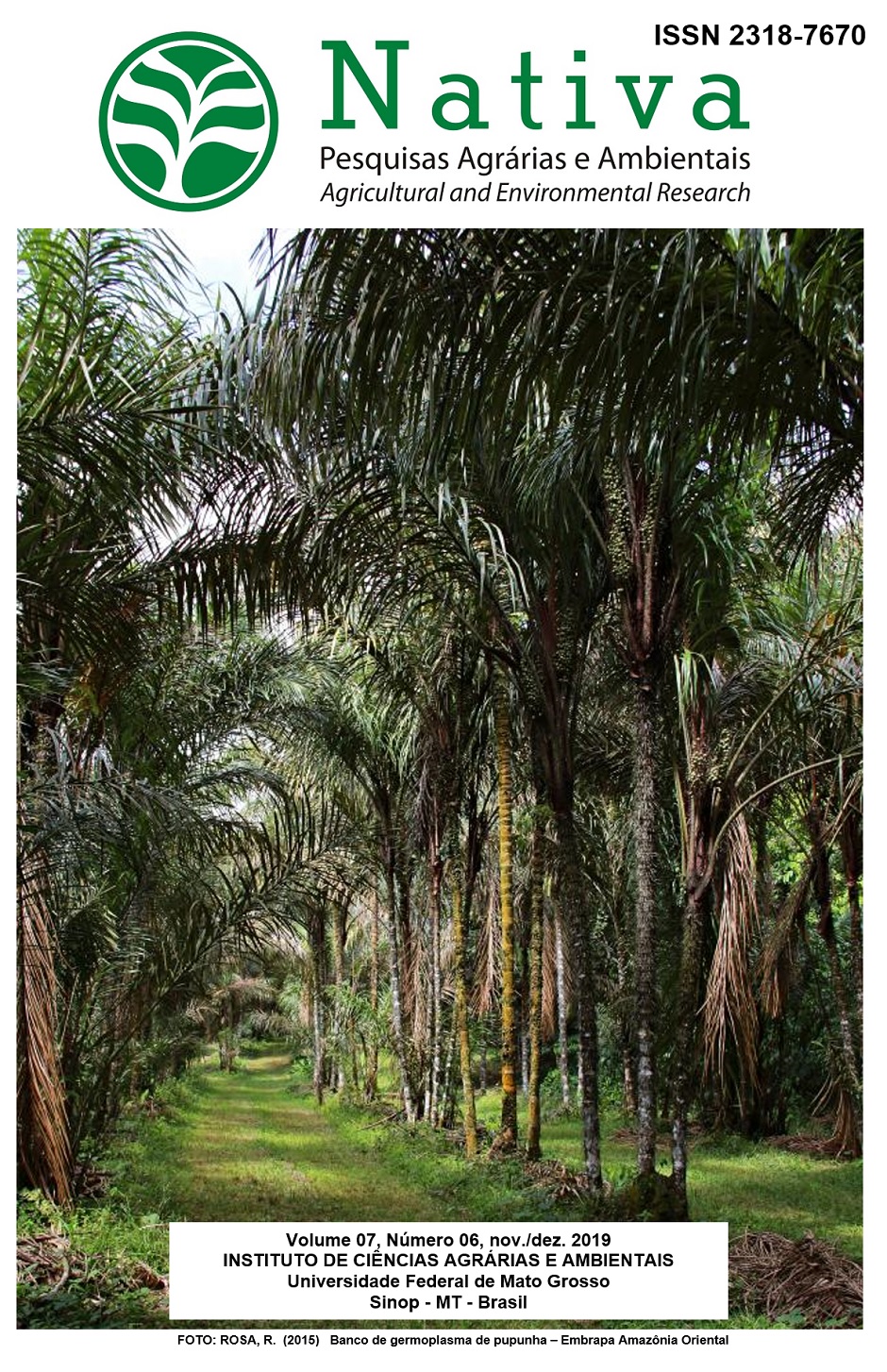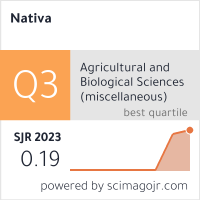GENETIC DISSIMILARITY BETWEEN LETTUCE GENOTYPES WITH DIFFERENT LEVELS OF CAROTENOIDS BIOFORTIFICATION
DOI:
https://doi.org/10.31413/nativa.v7i6.7331Resumo
DIVERSIDADE GENÉTICA ENTRE GENÓTIPOS DE ALFACE COM DIFERENTES NÍVEIS DE BIOFORTIFICAÇÃO POR CAROTENÓIDES
Alimentos ricos em carotenóides podem auxiliar na prevenção de diversas doenças. A alface é uma das hortaliças mais consumidas no mundo apresentando potencial para investimento em biofortificação. No entanto, existem poucos genótipos de alface biofortificado disponíveis no mercado, inclusive, para uso direto no melhoramento genético. Avaliar novos genótipos de alface ricos em carotenóides é essencial, a fim de se conhecer o potencial comercial e sua utilidade como potenciais genitores em programas de melhoramento. Portanto, o objetivo do trabalho foi avaliar o potencial agronômico e diversidade genética em genótipos de alface com diferentes níveis de carotenóides. O experimento foi conduzido em campo no delineamento de blocos casualizados, com 83 tratamentos e duas repetições. Foram avaliados dados quantitativos: teor de clorofila foliar a, b e total; diâmetro de copa e número de folhas; e dados qualitativos: tamanho, cor e formato de folha da alface. A divergência genética foi obtida por meio de análises multivariadas utilizando-se a soma de matrizes de dados qualitativos e quantitativos, e posteriormente empregando-se diferentes métodos de agrupamento (UPGMA e Tocher). Os genótipos apresentaram diversidade genética e potencial agronômico para diferentes segmentos de alfaces, aliado ao alto teor de carotenóides. Entre as variáveis respostas avaliadas, clorofila total representou maior contribuição para a variabilidade genética. Não houve coerência entre o método hierárquico UPGMA e de otimização Tocher para caracterização da divergência genética em genótipos de alfaces com diferentes níveis de carotenoides.
Palavras-chave: biofortificação; Lactuca sativa; variabilidade genética; vitamina A.
ABSTRACT:
Vegetables with high carotenoids content can help to prevent many diseases. Lettuce is one of the most consumed vegetables all over the world that present potential for biofortification investment. However, there are few genotypes of lettuce biofortificated on the market and for direct use in plant breeding. Evaluate new lettuce genotypes that are rich in carotenoids are essential in order to know the commercial potential and their usefulness as possible parents in breeding programs. Therefore, the experiment aimed to evaluate the agronomic potential and genetic dissimilarity between lettuce genotypes with different levels of carotenoids. It was conducted in a randomized block design, with 83 treatments and two replications. During the course of the trial, were evaluated quantitative characters: leaf chlorophyll content (a, b and total), canopy diameter and number of leaves; and qualitative characters: size, color and shape of the leaves. The genetic diversity was obtained by multivariate analyzes using the sum of quantitative and qualitative data and, after that, using different grouping methods (UPGMA and Tocher). The genotypes showed genetic dissimilarity and agronomic potential for different lettuce segments and high carotenoids content. Among the evaluated characters, total chlorophyll content represented the main contribution for genetic variability. There was no coherence between the hierarchical method of UPGMA and the optimization method of Tocher when used for determinate the genetic diversity between lettuce genotypes with different levels of carotenoids.
Keywords: biofortification; genetic variability; Lactuca sativa; vitamin A.
Referências
AZEVEDO, A. M.; ANDRADE JÚNIOR, V. C.; OLIVEIRA, C. M.; FERNANDES, J. S. C.; PEDROSA, C. E.; DORNAS, M. F. S.; CASTRO, B. M. C. Seleção de genótipos de alface para cultivo protegido: divergência genética e importância de caracteres. Horticultura Brasileira, Vitória da Conquista, v. 31, n. 2, p. 260-265, abr./jun. 2013. DOI: http://dx.doi.org/10.1590/S0102-05362013000200014
BOUIS, H. E.; HOTZ, C.; MCCLAFFERTY, B.; MEENAKSHI, J. V.; PFEIFFER, W. H. Biofortification: A New Tool to Reduce Micronutrient Malnutrition. Food and Nutrition Bulletin, Tokyo, v. 32, n. 1, p. 31S-40S, 2011. DOI: https://dx.doi.org/10.1177/15648265110321S105
CASSETARI, L. S.; GOMES, M. S.; SANTOS, D. C.; SANTIAGO, W. D.; ANDRADE, J.; GUIMARÃES, A. C.; SOUZA, J. A.; CARDOSO, M. G.; MALUF, W. R.; GOMES, L. A. Β-carotene and chlorophyll levels in cultivars and breeding lines of lettuce. Acta Horticulturae, The Hague, v. 1083, p. 469-473, 2015. DOI: http://dx.doi.org/10.17660/ActaHortic.2015.1083.60
CRUZ, C. D. GENES: a software package for analysis in experimental statistics and quantitative genetics. Acta ScientiarumAgronomy, Maringá, v. 35, n. 3, p. 271-276, 2013. DOI: http://dx.doi.org/10.4025/actasciagron.v35i3.21251
CRUZ, R.; BAPTISTA, P.; CUNHA, S.; PEREIRA, J. A.; CASAL, S. Carotenoids of lettuce (lactuca sativa l.) grown on soil enriched with spent coffee grounds. Molecules, Basel, v. 17, n. 2, p. 1535-1547, 2012.DOI: http://dx.doi.org/10.3390/molecules17021535
DAMERUM, A.; SELMES, S. L.; BIGGI, G. F.; CLARKSON, G. J.; ROTHWELL, S. D.; TRUCO, M. J.; MICHELMORE, R. W.; HANCOCK, R. D.; SHELLCOCK, C.; CHAPMAN, M. A.; TAYLOR, G. Elucidating the genetic basis of antioxidant status in lettuce (Lactuca sativa). Horticulture research, v. 2, p. 15055, nov. 2015. DOI: http://dx.doi.org/10.1038/hortres.2015.55
FILGUEIRA, F. A. R. Novo manual de olericultura: agrotecnologia moderna na produção e comercialização de hortaliças. 3. ed. Viçosa: Editora UFV, 2008. 422p.
KŘÍSTKOVÁ, E.; DOLEŽALOVÁ, I.; LEBEDA, A.; VINTER, V.; NOVOTNÁ, A. Description of morphological characters of lettuce (Lactuca sativa L.) genetic resources. Horticultural Science, Prague, v. 35, n. 3, p. 113-129, 2008. DOI: http://dx.doi.org/10.17221/4/2008-HORTSCI
LEBEDA, A.; KŘÍSTKOVÁ, E.; KITNER, M.; MIESLEROVÁ, B.; JEMELKOVÁ, M.; PINK, D. A. C. Wild Lactuca species, their genetic diversity, resistance to diseases and pests, and exploitation in lettuce breeding. European Journal of Plant Pathology, Dordrecht, v. 138, n. 3, p. 597-640, 2014. DOI: http://dx.doi.org/10.1007/s10658-013-0254-z
MAIANI, G.; CASTÓN, M. J.; CATASTA, G.; TOTI, E.; CAMBRODÓN, I. G.; BYSTED, A.; GRANADO-LORENCIO, F.; OLMEDILLA-ALONSO, B.; KNUTHSEN, P.; VALOTI, M.; BÖHM, V.; MAYER-MIEBACH, E.; BEHSNILIAN, D.; SCHLEMMER, U. Carotenoids: Actual knowledge on food sources, intakes, stability and bioavailability and their protective role in humans. Molecular nutrition & food research, Weinheim, v. 53, n. 2, p. 194-218, 2009. DOI: http://dx.doi.org/10.1002/mnfr.200800053
MANTEL, N. The detection of disease clustering and a generalized regression approach. Cancer Research, v. 27, n. 2, p. 209-220, 1967.
MATTOS, L. M.; MORETTI, C. L.; MOURA, M. A.; MALDONADE, I. R.; SILVA, E. Y. Y. Produção segura e rastreabilidade de hortaliças. Horticultura Brasileira, Vitória da Conquista, v. 27, n. 4, p. 408-413, out./dez. 2009. DOI: http://dx.doi.org/10.1590/S0102-05362009000400002
MILAGRES, R. C. R. M.; NUNES, L. C.; PINHEIRO-SANT’ANA, H. M. A deficiência de vitamina A em crianças no Brasil e no mundo. Ciência & Saúde Coletiva, Rio de Janeiro, v. 12, n. 5, p. 1253-1266, 2007. DOI: http://dx.doi.org/10.1590/S1413-81232007000500023
MOU, B. Genetic variation of beta-carotene na lutein contents in Lettuce. Journal of American Society for Horticultural Science, Alexandria, v. 130, n. 6, p. 870-876, 2005. DOI: http://dx.doi.org/10.21273/JASHS.130.6.870
PIENIZ, S.; COLPO, E.; OLIVEIRA, V. R.; ESTEFANEL, V.; ANDREAZZA, R. Avaliação in vitro do potencial antioxidante de frutas e hortaliças. Ciência e Agrotecnologia, Lavras, v. 33, n. 2, p. 552-559, mar./abr. 2009. DOI: http://dx.doi.org/10.1590/S1413-70542009000200030
RAMALHO, R.; PADILHA, P.; SAUNDERS, C. Análise crítica de estudos brasileiros sobre deficiência de vitamina A no grupo materno-infantil. Revista Paulista de Pediatria, São Paulo, v. 26, n. 4, p. 392-9, 2008. DOI: http://dx.doi.org/10.1590/S0103-05822008000400014
SALA, F. C.; COSTA, C. P. Retrospectiva e tendência da alfacicultura brasileira. Horticultura Brasileira, Vitória da Conquista, v. 30, n. 2, p. 187-194, abr./jun. 2012. DOI: http://dx.doi.org/10.1590/S0102-05362012000200002
SILVA, S. A.; SILVA-MANN, R.; CARVALHO, S. V. A. Diversidade Genética e Seleção Assistida por Marcadores moleculares RAPD em populações de alface. Scientia Plena, Aracajú, v. 6, n. 3, p. 1-9, 2010.
SINGH, D. The relative importance ofcharacters affecting genetic divergence. The Indian Journal of Genetic and Plant Breeding, v. 41, n. 2, p. 237-245, 1981.
SOUSA, C. S.; BONETTI, A. M.; GOULART FILHO, L. R.; MACHADO, J. R. A.; LONDE, L. N.; BAFFI, M. A.; RAMOS, R. G.; VIEIRA, C. U.; KEER, W. E. Divergência genética entre genótipos de alface por meio de marcadores AFLP. Bragantia, Campinas, v. 66, n. 1, p. 11-16, 2007. DOI: http://dx.doi.org/10.1590/S0006-87052007000100002
TREUREN, R. V.; HINTUN, T. J. L. V. Comparison of anonymous and targeted molecular markers for the estimation of genetic diversity in exsitu conserved Lactuca. Theoretical and Applied Genetics, Berlin, v. 119, p. 1265-1279, nov. 2009. DOI: http://dx.doi.org/10.1007/s00122-009-1131-1
Downloads
Publicado
Edição
Seção
Como Citar
Licença
Direitos Autorais para artigos publicados nesta revista são do autor, com direitos de primeira publicação para a revista. Em virtude de a aparecerem nesta revista de acesso público, os artigos são de uso gratuito, com atribuições próprias, em aplicações educacionais e não-comerciais.
A artigos publicados nessa revista, podem ser reproduzidos parcialmente ou utilizados como referência por outros autores, desde que seja cita a fonte, ou seja, a Revista Nativa.
Copyright for articles published in this journal are the authors, with first publication rights granted to the journal. The journal shows open access, and articles are free to use, with proper attribution, in educational and non-commercial.
The articles published in this journal may be reproduced in part or used as a reference by other authors, provided that the source is quoted.






